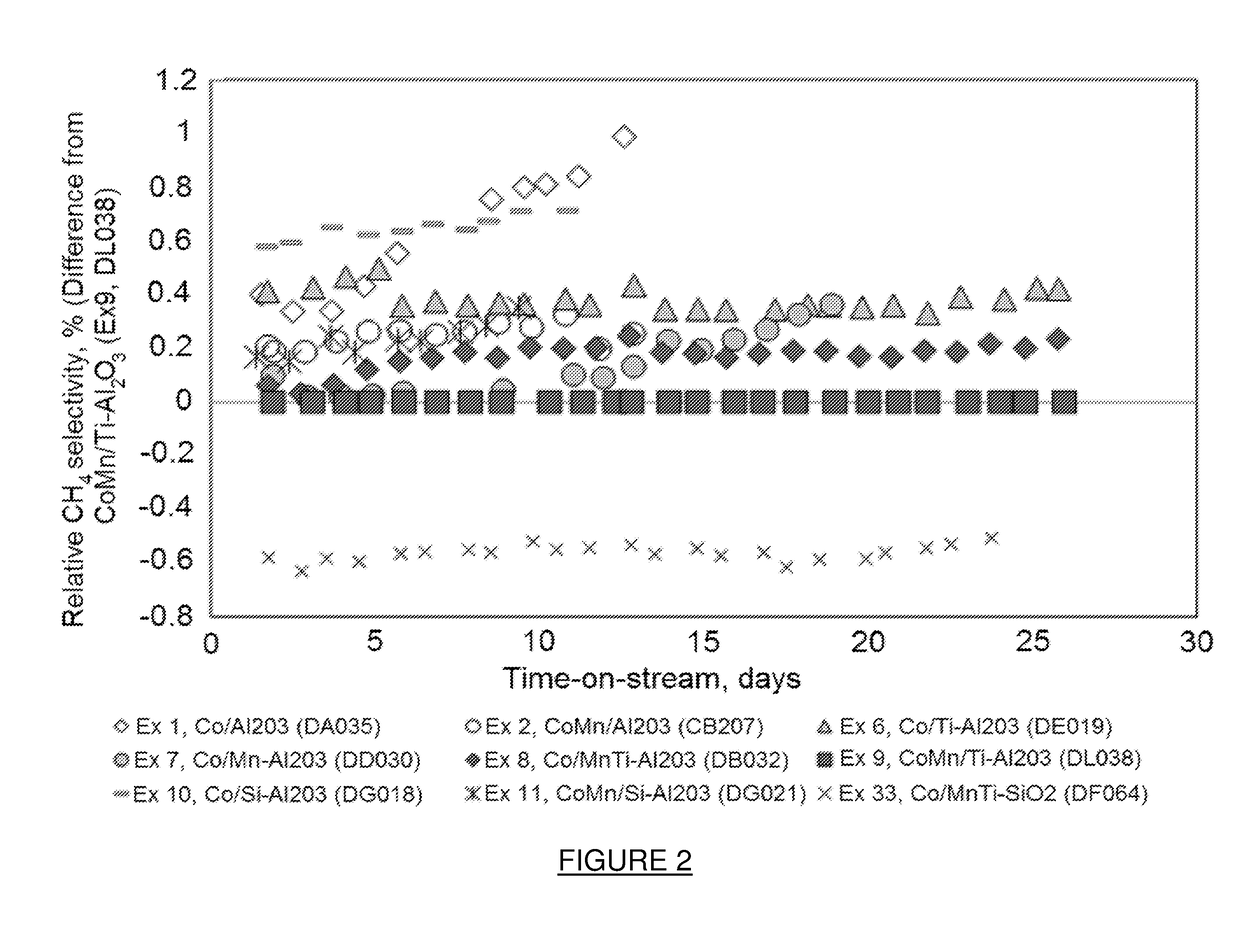Hydrocarbon Synthesis Catalyst, Its Preparation Process and Its Use
- Summary
- Abstract
- Description
- Claims
- Application Information
AI Technical Summary
Benefits of technology
Problems solved by technology
Method used
Image
Examples
example 15
[0196]The calcined catalyst precursors were reduced prior to Fischer-Tropsch synthesis using pure H2 flowing at 2.0 Nm3 / kgCatalyst / hour at atmospheric pressure. The following heating profile was used, 1° C. / min to 110° C. hold 3 hours followed with, 1° C. / min to 425° C. hold 10 hours. The reduced catalyst was cooled down to room temperature and suspended into molten wax and loaded in a CSTR under an inert gas blanket (argon or nitrogen).
example 16
opsch Synthesis
[0197]The activated and wax protected catalysts, as described in Example 15, were tested for their slurry phase FTS performance in a laboratory micro slurry CSTR at a reactor temperature of 230° C. and a reactor pressure of about 22 bar during which a pure H2 and CO and Ar feed gas mixture was utilised with a ˜5% Ar content and a total feed molar H2 / CO ratio of about 1.8. This reactor was electrically heated and sufficiently high stirrer speeds were employed as to eliminate any gas-liquid mass transfer limitations. The feed gas space velocity was changed such that the syngas conversion was around 78±1%. The water partial pressure was about 10 bar.
Discussion
Example 9 (Co / 3.1 g Mn / 100 g Ti—Al2O3) Showed Initial Catalyst Deactivation, However, after 5 Days On-Line the Catalyst Performance Stabilized and Remained Stable Over a 50 Day Period
[0198]FIG. 1 shows the percentage difference in FT rate for Examples 1, 2, 6-8, 10, 11 and 33 relative to Example 9 and can be calcula...
example 17
opsch Synthesis
[0204]The activated and wax protected catalysts, as described in Example 15, for Examples 8 and 9 were tested for their slurry phase FTS performance in a laboratory micro slurry CSTR at a reactor temperature of 230° C. and a reactor pressure of about 19 bar during which a pure H2, CO and Ar feed gas mixture was utilised with a 10% Ar content and a total feed molar H2 / CO ratio of ˜1.5.
[0205]This reactor was electrically heated and sufficiently high stirrer speeds were employed as to eliminate any gas-liquid mass transfer limitations. The feed gas space velocity was changed such that the syngas conversion was around 72±1%. The water partial pressure was about 6 bar.
[0206]Examples 8 and 9 were tested under the conditions described in Example 17. As can be seen from Table 5, Example 8, containing the MnTi support modification and Example 9 (containing Mn as promoter and Ti as support modifier) showed comparable relative FT activities and methane selectivities with time on...
PUM
| Property | Measurement | Unit |
|---|---|---|
| Temperature | aaaaa | aaaaa |
| Pressure | aaaaa | aaaaa |
| Temperature | aaaaa | aaaaa |
Abstract
Description
Claims
Application Information
 Login to View More
Login to View More - R&D
- Intellectual Property
- Life Sciences
- Materials
- Tech Scout
- Unparalleled Data Quality
- Higher Quality Content
- 60% Fewer Hallucinations
Browse by: Latest US Patents, China's latest patents, Technical Efficacy Thesaurus, Application Domain, Technology Topic, Popular Technical Reports.
© 2025 PatSnap. All rights reserved.Legal|Privacy policy|Modern Slavery Act Transparency Statement|Sitemap|About US| Contact US: help@patsnap.com



